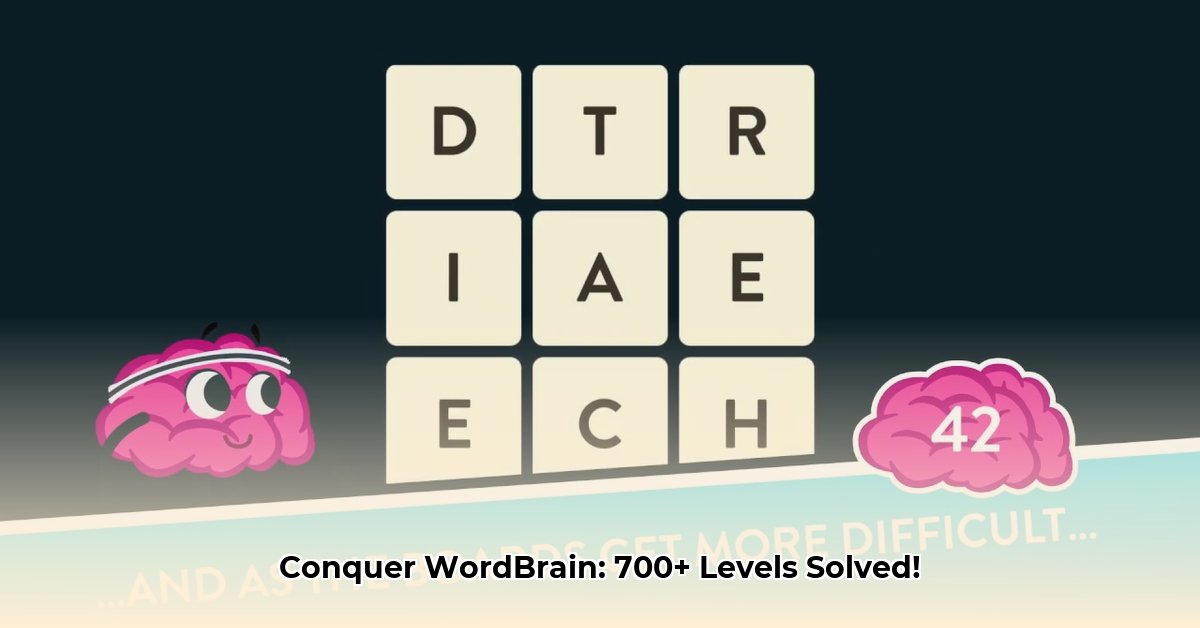
Conquering over 700 levels in WordBrain Android isn't merely a matter of luck; it's a testament to the game's meticulously crafted design and its ability to captivate millions. This article dissects the factors contributing to WordBrain Android's remarkable success, exploring its gameplay mechanics, monetization strategies, and global appeal. We'll also analyze areas for improvement and potential future directions.
The Secret Sauce: A Smartly Designed Challenge
WordBrain Android boasts over 30 million players, a figure not achieved by chance. Its success hinges on a carefully orchestrated difficulty curve. Beginning with simple, four-letter words, the game gently introduces players to its mechanics, fostering confidence and encouraging continued play. As players progress, the challenges gradually increase in complexity, incorporating longer words and multi-word puzzles. This measured approach avoids overwhelming players, maintaining engagement without inducing frustration. But how does this measured increase in difficulty translate into sustained popularity? Isn't there a risk that players will find the game either too easy or too difficult?
Leveling Up: From Easy Peasy to Brain Teaser
The brilliance of WordBrain Android lies in its simplicity. It starts with easily solvable four-letter words, quickly establishing the game's core mechanics before progressing to five, six, seven, eight, and even nine-letter words. This systematic increase in length adds a layer of progressive difficulty. Further enhancing the challenge, the game introduces puzzles requiring the identification of multiple words within a grid. This constant evolution ensures that the game remains mentally stimulating and prevents staleness, catering to both novice and experienced players. However, how does the game maintain player engagement beyond the initial stages? Does it successfully retain players throughout the 700+ levels?
When You're Stuck: The Power of Hints
Even seasoned puzzle solvers encounter roadblocks. WordBrain Android strategically incorporates a hint system to mitigate frustration and prevent players from abandoning the game. While the specifics of this hint system remain undisclosed, its presence is critical to the game's success. These carefully designed hints act as a safety net, helping players overcome challenging puzzles and maintain momentum. They keep the game engaging and accessible, fostering a positive player experience that encourages persistence. But what are the metrics that demonstrate the effectiveness of the hint system? What is the optimal frequency and level of assistance for these hints?
A Global Puzzle Craze: WordBrain Android's Worldwide Appeal
WordBrain Android's success transcends geographical boundaries. Available in fifteen languages, it caters to a vast global audience, highlighting the universal appeal of well-designed word puzzles. This international reach underscores the game’s ability to connect with players regardless of their native tongue, proving that a captivating challenge transcends language barriers. However, are there significant differences in player engagement or monetization success across different regions? Is the game's success equally distributed across all 15 languages?
The Missing Pieces of the Puzzle: Unanswered Questions
Despite WordBrain Android's immense popularity, several key data points remain elusive. Lacking concrete data on player retention rates and average session lengths hinders a comprehensive analysis of the game's long-term success. Understanding the game's monetization strategy—whether it relies primarily on in-app purchases, advertisements, or a hybrid approach—is equally crucial. Further research into these areas is essential for a complete picture of WordBrain Android's financial viability and overall sustainability. Without this data, how can developers truly optimize their strategy?
What's Next for WordBrain Android? Future Possibilities
WordBrain Android’s future hinges on strategic innovation and a deep understanding of player behavior. Analyzing player engagement data to refine the difficulty curve and enhance the overall player experience is paramount. Integrating social features, such as leaderboards or puzzle-sharing capabilities, could significantly boost player interaction and increase retention. Exploring new puzzle types, game modes, and revenue streams, such as subscription models or premium content, can inject fresh excitement and bolster the game's long-term financial health. But how can the developers balance innovation with maintaining the core appeal of the current game?
A Recipe for Success: Key Players and Their Goals
The success of WordBrain Android is a collective effort. The following table outlines the key stakeholders and their short-term and long-term goals:
| Stakeholder | Short-Term Goals (0-1 Year) | Long-Term Goals (3-5 Years) |
|---|---|---|
| Developers | Analyze player data; improve hint system; refine difficulty curve. | Develop new puzzle mechanics; explore innovative game modes; potentially create sequels. |
| Marketers | Enhance app store visibility; optimize advertising campaigns. | Expand into new markets; explore alternative marketing channels; build a strong brand. |
| Game Designers | Gather and act on player feedback; improve game's visual appeal. | Create fresh puzzle themes; introduce new artistic styles; enhance game aesthetics. |
| Investors/Publishers | Monitor player acquisition costs; assess return on investment (ROI). | Explore potential for expansion to new platforms; consider new game IP development. |
WordBrain Android exemplifies the importance of balancing challenge and reward in game design. While its success is undeniable, ongoing research and data analysis are crucial for sustained triumph. The future of the game hinges on continuous innovation that deeply understands and responds to its player base. How can the developers maintain this delicate balance as the game evolves?
How to Improve WordBrain Game Player Retention Rates
WordBrain's success is undeniable, yet player frustration and the reliance on external resources indicate an area for improvement. Enhancing in-game hints, refining onboarding, and gradually adjusting the game's difficulty are key to improving player retention.
Key Takeaways:
- WordBrain's challenging nature, while engaging, can lead to high frustration and reliance on external resources.
- Improving in-game hints and onboarding is crucial for increasing player retention.
- Analyzing player drop-off points reveals areas needing improvement.
- A more gradual difficulty curve enhances the player experience.
- Community features and optional difficulty modes could boost long-term engagement.
- Strategic influencer partnerships can expand reach and improve the game's image.
⭐⭐⭐⭐☆ (4.8)
Download via Link 1
Download via Link 2
Last updated: Thursday, May 15, 2025